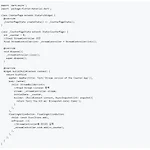Notice
Recent Posts
Recent Comments
반응형
목록2018/10/08 (1)
오늘도 공부
 Reactive Programming part 1 - Stream
Reactive Programming part 1 - Stream
Reactive Programming part 1 - Stream스트림이란 무엇인가?스트림을 이해하기 위해선 파이프를 상상해야 한다.뭔가를 입력을 했다면 그것이 파이프 안에서 흘러서 다른 출구쪽으로 배출 되는 걸 뜻한다.그럼 Flutter 을 대입해보자면파이프는 Stream 이라고 부른다.Stream을 제어하기위해 우리는 자주 StreamController 를 이용한다.Stream 입력하기 하기 위해 StreamSink 를 사용한다.입력 할수 있는 것들은 어떤 것이든 가능하다.데이터, 오브젝트, map, 에러코드, 이벤트, 심지어 다른 스트림도 가능하다.배출은 어떻게 확인하나?일단 입력이 되면 Rx 처럼 subscribe 를 통해서 받을 수 있다. 이 과정을 flutter에서는 listen 한다고 말한다..
스터디/Flutter
2018. 10. 8. 16:32

